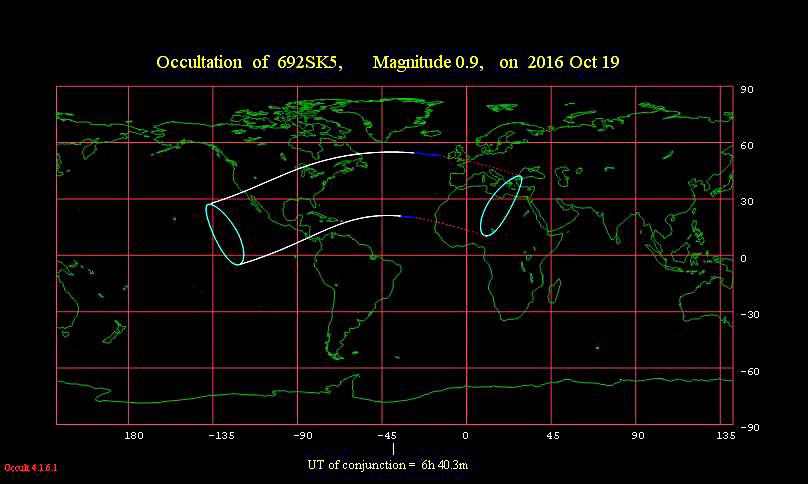Tonight – October 18, 2016 – features the bright waning gibbous moon close to the star Aldebaran or occulting (covering over) Aldebaran. The two luminaries rise over the eastern horizon by mid-evening tonight at mid-northern latitudes – and at late night at southerly latitudes. Last night, on October 17, a larger waning gibbous moon shone closer to the Pleiades star cluster. With the moon shining so close to Aldebaran, the fiery eye of the Bull, it might be hard to spot Aldebaran in the lunar glare. If so, try blocking out the moon with your finger, and then look for the star Aldebaran. The Pleiades star cluster – also known as the Seven Sisters – will probably be even harder than Aldebaran to see in tonight’s moon-drenched sky, but you’ll enjoy them, too, if you can pick them out.
After the moon, Aldebaran and the Pleiades cluster rise tonight, the threesome goes westward across the sky for rest of the night. From temperate latitudes in the Southern Hemisphere, the moon, Aldebaran and Pleiades probably won’t rise till after bedtime, in which case you can view the moon, Aldebaran and the Pleiades before dawn on October 19.

The moon will actually occult – cover over – the star Aldebaran for a portion of the night tonight (October 18-19) from much of the United States, Mexico, the Caribbean, Central America and southeast Canada. Aldebaran will disappear behind the lit side of the moon and reappear on the moon’s dark side.
We give the occultation times for various North American localities in their respective time zones. No need to convert from Universal Time to local time!
Halifax, Nova Scotia (October 19, 2016)
Occultation begins: 2:08 a.m. Atlantic Daylight Time
Occultation ends: 3:06 a.m. Atlantic Daylight Time
Philadelphia, Pennsylvania (October 19, 2016)
Occultation begins: 1:41 a.m. Eastern Daylight Time
Occultation ends: 2:48 a.m. Eastern Daylight Time
Austin, Texas (October 19, 2016)
Occultation begins: 12:04 a.m. Central Daylight Time
Occultation ends: 1:03 a.m. Central Daylight Time
Santa Fe, New Mexico (October 18, 2016)
Occultation begins: 10:44 p.m. Mountain Daylight Time
Occultation ends: 11:46 p.m. Mountain Daylight Time
San Diego, California (October 18, 2016)
Occultation begins 10:15 p.m. Pacific Daylight Time
Occultation ends: 10:36 p.m. Pacific Daylight Time.
Click here to find out when the moon occults Aldebaran at many, many other localities in the occultation viewing area. The listed times on this page are given in Universal Time and must be converted to local time. The occultation begins when Aldebaran slips behind the lit side of the waning gibbous moon, and the occultation ends when this star comes out again from behind the dark side of the moon.
To convert from Universal Time (UT):
Newfoundland Daylight Time: UT – 2.5 hours
Atlantic Daylight Time: UT – 3 hours
Eastern Daylight Time: UT – 4 hours
Central Daylight Time: UT – 5 hours
Mountain Daylight Time: UT – 6 hours
Pacific Daylight Time: UT – 7 hours
If you live along the white line on the map near the top of this post, you can watch a grazing occultation, which means the star will flit in and out of view along the moon’s limb. Click here for more graze maps and information.
Aldebaran and the Pleiades star cluster return to the same place in the sky about 4 minutes earlier every night. The moon, on the other hand, rises an average 50 minutes later daily. So several days from now, after the moon has left Taurus, be sure to see the starlit Bull in all his majesty, and the star Aldebaran plus the beautiful Pleiades cluster in a moon-free sky!
Bottom line: The moon is near Aldebaran on the night of October 18, 2016. You’ll recognize the Pleiades as a tiny misty dipper. It’s sometimes called the Seven Sisters. Aldebaran will be the bright, reddish star nearby.
Arcturus is a Halloween ghost of the summer sun
EarthSky lunar calendars are cool! They make great gifts. Order now. Going fast!












